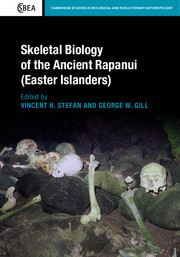Book contents
- Frontmatter
- Contents
- List of contributors
- Acknowledgements
- 1 Introduction: Research overview
- 2 Review of Polynesian and Pacific skeletal biology
- 3 Chronology and Easter Island prehistory
- 4 A descriptive skeletal biology analysis of the ancient Easter Island population
- 5 Craniometric variation of the prehistoric Polynesians and Rapanui
- 6 Rapanui non-metric cranial traits
- 7 Intra-island discrete cranial trait variation
- 8 Continuous non-metric characteristics of the early Rapanui
- 9 Rapanui dental morphology
- 10 Pelvic variability and sexual dimorphism in prehistoric Rapanui
- 11 Genetic affinities of the Rapanui
- 12 Archaeogenetics and paleodemographic estimation of founding populations: Features of residential geography on Rapa Nui
- 13 Evidence for injuries and violent death
- 14 Demographic analysis of modified crania from Rapa Nui
- 15 East Polynesian and Paleoindian parallels and contrasts in skeletal morphology
- 16 Rapanui origins, relationships, and warfare: A summary in theoretical context
- References
- Index
5 - Craniometric variation of the prehistoric Polynesians and Rapanui
Published online by Cambridge University Press: 05 December 2015
- Frontmatter
- Contents
- List of contributors
- Acknowledgements
- 1 Introduction: Research overview
- 2 Review of Polynesian and Pacific skeletal biology
- 3 Chronology and Easter Island prehistory
- 4 A descriptive skeletal biology analysis of the ancient Easter Island population
- 5 Craniometric variation of the prehistoric Polynesians and Rapanui
- 6 Rapanui non-metric cranial traits
- 7 Intra-island discrete cranial trait variation
- 8 Continuous non-metric characteristics of the early Rapanui
- 9 Rapanui dental morphology
- 10 Pelvic variability and sexual dimorphism in prehistoric Rapanui
- 11 Genetic affinities of the Rapanui
- 12 Archaeogenetics and paleodemographic estimation of founding populations: Features of residential geography on Rapa Nui
- 13 Evidence for injuries and violent death
- 14 Demographic analysis of modified crania from Rapa Nui
- 15 East Polynesian and Paleoindian parallels and contrasts in skeletal morphology
- 16 Rapanui origins, relationships, and warfare: A summary in theoretical context
- References
- Index
Summary
The origin, migration, evolution, and interaction of Polynesian populations as a whole, as well as focused examination of specific islands or archipelagoes (i.e., Rapanui [Easter Islanders], Marquesas Islands, etc.) have been the center of Pacific investigation for many years. The prehistoric Polynesians are a culturally, linguistically, and biologically distinct group of humans. As one of the most widely dispersed peoples of the earth, the Polynesians have excited extensive theorizing about their origins. For over 200 years, theories have been multitudinous, confusing, contradictory, and ranging from scholarly to charlatanic and even on the lunatic fringe (Bellwood, 1979). No progress was made into the question of Polynesian origins until serious archaeological investigations were conducted, with primary attention focused on the migration route by which the ancestral Polynesians reached the islands of the Pacific.
The development of an ancestral Polynesian society from a Lapita Cultural Complex (Green, 1976; Kirch, 1989), and the subsequent dispersal of Polynesian colonizers throughout the Eastern Pacific had been readily accepted by most authorities. The Lapita Cultural Complex was believed to have originated in mainland Southern China and dispersed to Taiwan circa 4000 BC, with further dispersal to Melanesia via the Philippines and the Indonesian Archipelago occurring circa 3000 BC (Bellwood, 1979; Suggs, 1960; Van Tilburg, 1994). Bellwood (1991) refined this hypothesis concerning Polynesian origins, suggesting that the Polynesians originated in a demic expansion of Austronesian-speaking agriculturists from the South China mainland, approximately 6,000 years ago, and spread successively to Taiwan, the Philippines, Eastern Indonesia, and then Melanesia, reaching Fiji by about 3,500 years ago. From Fiji, they dispersed through Somoa/Tonga into East Polynesia about 2,000 years ago (Burley and Dickinson, 2001). This scenario has also come to be known as the “express train to Polynesia” (Diamond, 1988).
Chromosomal and mitochondrial DNA research has provided much information regarding the origins of the Polynesians. Several nuclear DNA markers (α-globin gene cluster – chromosome 16p13.3; β-globin gene cluster – chromosome 11p15; phenylalinine hydroxylase gene – chromosome 12q22-q24.1; human leukocyte antigen) have been examined and have indicated a close relationship to populations of Southeast Asia (Hertzberg et al., 1991; Hill et al., 1987; Serjeantson, 1985; Serjeantson et al., 1987; Trent et al., 1988). Analysis of these DNA markers has also indicated no or limited relationship to the Melanesians.
- Type
- Chapter
- Information
- Skeletal Biology of the Ancient Rapanui (Easter Islanders) , pp. 89 - 107Publisher: Cambridge University PressPrint publication year: 2016



